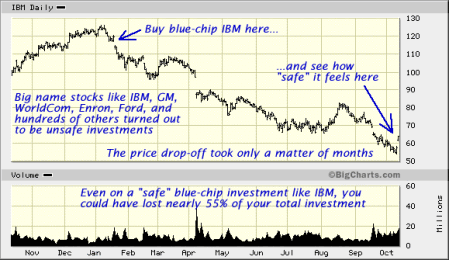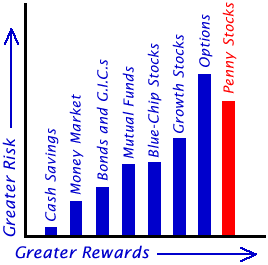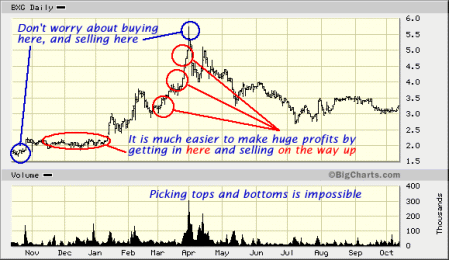


Get Instant Penny Stock Picks from the Authority!Visit www.PeterLeeds.com Right Now!
Enron, Bre-X, WorldCom, and Anderson Consulting were all Blue-Chips at one point in their life cycle, before dropping towards or close to $0.
Other blue-chip stocks like Microsoft saw losses from their high of $120 that brought the shares down to $40, for a loss of two-thirds of the total value in about 1 year's time. Blue-chips are plenty dangerous.

This is true if you look back many, many years and compare the level of the overall exchanges to current prices. However, in that time the stocks that make up the indexes have been shuffled, with poor performers being removed in exchange for companies that have seen tremendous growth.
As well, if you do not have the patience to hold on to shares for 50 years, and instead hold on for a ten year window, history shows that you may or may not see significant gains, depending on when you first invested.

This is an over-simplified take on the risk-reward ratio. It is possible, using certain investment methodologies such as Leeds Analysis, to lower your risk in penny stocks, while limiting your investments to those with high potential.
The Internet bubble that burst in April of 2000 is a great example of investing with the crowd. The majority of investors got burned (and burned badly) by the collapse that followed, which saw the NASDAQ fall from over 5,000 to lows of 1,300. Generally, the crowd gets slaughtered.
Warren Buffet, the great investor, once said, "Give everybody else the top 5% and the bottom 5%. I'll take everything that's left in between."
Picking bottoms and tops has proven to be impossible, even for 'experts' and market gurus. In your attempt to capture penny stocks at their absolute lows, you may end up costing yourself much more than if you had just got involved in a penny stock's trend on the way up.

This could not be more wrong. Every time a speculative bubble builds up, people dismiss the fears of others by explaining that, "It's different this time because..." or perhaps they say, "The stock market CAN continue to climb endlessly, because..."
They cite things like, "New economic policy," "technology creating totally efficient markets," and other things they don't really understand, in order to justify their unwary approach to greed. Just like it has dozens of times in recent history, it always ends the same way.
In some cases, sure. But often 'boring' companies, like oil producers, waste disposal companies, and agricultural services, are overlooked by investors because of their mundane nature. When these companies then begin to turn huge profits and the street can not ignore them any longer, they can be incredibly rewarding to own. This is especially true if they were undervalued penny stocks, and therefore can make big percentage moves.
In many cases, a growing industry or field simply gives rise to more competitors. If the number of people entering old age homes per month doubled or tripled, there would be an increase in companies offering locations/accommodations, as much as there would be an increase in business from existing players in the sector.
They often have very educated, very good opinions. However, they don't know the best stocks to invest in simply because they are in the industry. Stock brokers make a living facilitating transactions - their job is administrative, not analytical.
If the technology is already well-known, as is the potential for the company, the shares may have already swelled in price. If it seems obvious that the penny stock will do well, you may pay too much for shares, especially if you are not getting involved very early.
As well, it takes a lot more than a good technology or idea to make a company run, and subsequently to build shareholder value.
Thomas Edison, the great inventor, once said, "An idea is 1%, hard work makes up the other 99%.